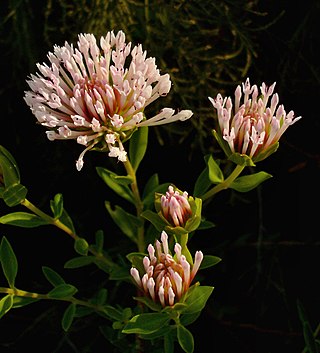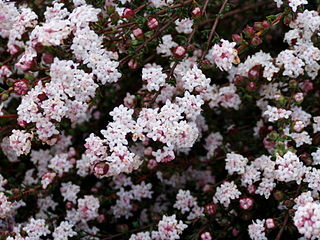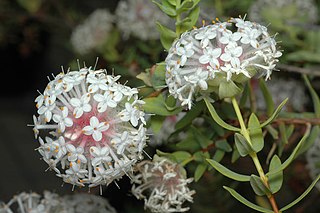
Pimelea calcicola is a species of flowering plant in the family Thymelaeaceae and is endemic to part of the west coast of Western Australia. It is an erect to spreading shrub with elliptic leaves arranged in opposite pairs, and head-like racemes of pale to deep pink, tube-shaped flowers surrounded by leaf-like involucral bracts.

Pimelea ferruginea, commonly known as pink rice flower or coastal banjine, is a species of flowering plant in the family Thymelaeaceae and is endemic to near-coastal areas of south-western Western Australia. It is a dense, erect shrub with elliptic to narrowly elliptic leaves and head-like clusters of pale to deep pink, tube-shaped flowers.

Pimelea brachyphylla is a species of flowering plant in the family Thymelaeaceae and is endemic to the south-west of Western Australia. It is an erect to spreading shrub with linear to elliptic leaves and clusters of white, tube-shaped flowers.

Pimelea curviflora, also known as curved rice-flower, is a shrub in the family Thymelaeaceae and is endemic to Australia. It is a small, hairy shrub with greenish-yellow or red tubular flowers.

Pimelea argentea, commonly known as silvery leaved pimelea, is a species of flowering plant in the family Thymelaeaceae and is endemic to the south-west of Western Australia. It is an erect shrub with densely hairy young stems and leaves, the leaves linear to elliptic, and heads of white to yellow or greenish flowers, the male and female flowers on separate plants.

Pimelea avonensis is a species of flowering plant in the family Thymelaeaceae and is endemic to the south-west of Western Australia. It is a shrub with narrowly egg-shaped or elliptic leaves and clusters of white, tube-shaped flowers.
Pimelea brevifolia is a species of flowering plant in the family Thymelaeaceae and is endemic to the south-west of Western Australia. It is an undershrub or shrub with erect, elliptic leaves, and heads of white flowers surrounded by four involucral bracts.

Pimelea brevistyla is a species of flowering plant in the family Thymelaeaceae and is endemic to the south-west of Western Australia. It is a shrub with narrowly egg-shaped leaves arranged in opposite pairs, and head-like racemes of white, tube-shaped flowers surrounded by yellowish involucral bracts.
Pimelea clavata is a species of flowering plant in the family Thymelaeaceae and is endemic to near-coastal areas and offshore islands of southern Western Australia. It is an erect shrub with narrowly elliptic to more or less linear leaves arranged in opposite pairs, and head-like clusters of white to pale yellow, tube-shaped flowers surrounded by leaf-like involucral bracts.
Pimelea concreta is a species of flowering plant in the family Thymelaeaceae and is native to northern Australia and parts of Indonesia. It is an annual herb with narrowly egg-shaped leaves and head-like clusters of white or pink, tube-shaped flowers surrounded by egg-shaped green involucral bracts.

Pimelea floribunda is a species of flowering plant in the family Thymelaeaceae and is endemic to the south-west of Western Australia. It is a shrub with narrowly elliptic to egg-shaped leaves arranged in opposite pairs, and drooping, head-like clusters of white or cream-coloured, tube-shaped flowers.
Pimelea forrestiana is a species of flowering plant in the family Thymelaeaceae and is endemic to Western Australia. It is a shrub with linear to narrowly elliptic leaves arranged in opposite pairs, and head-like clusters of yellow, tube-shaped flowers.
Pimelea gilgiana is a species of flowering plant in the family Thymelaeaceae and is endemic to near-coastal areas of north-western Western Australia. It is a shrub with narrowly egg-shaped leaves and head-like clusters of white or pinkish, dioecious flowers.
Cryptandra imbricata is a flowering plant in the family Rhamnaceae and is endemic to the southwest of Western Australia. It is a spreading shrub with spiny, interlaced branchlets, narrowly oblong to linear leaves and spike-like clusters of white, tube-shaped flowers.
Stenanthemum limitatum is a species of flowering plant in the family Rhamnaceae and is endemic to the southwest of Western Australia. It is an erect or straggling shrub with sparsely hairy young stems, egg-shaped to fan-shaped leaves and greyish, softly-hairy heads of white or cream-coloured flowers.
Pimelea holroydii is a species of flowering plant in the family Thymelaeaceae and is endemic to the north of Western Australia. It is an erect shrub with egg-shaped leaves arranged more or less in opposite pairs, and head-like clusters of white or cream-coloured, tube-shaped flowers.
Stenanthemum mediale is a species of flowering plant in the family Rhamnaceae and is endemic to inland Western Australia. It is an erect shrub with densely hairy young stems, egg-shaped leaves and densely hairy heads of silvery to rust-coloured flowers.

Stenanthemum nanum is a species of flowering plant in the family Rhamnaceae and is endemic to the south-west of Western Australia. It is a prostrate shrub with hairy young stems, broadly egg-shaped leaves with the narrower end towards the base, and densely silvery-hairy heads of white or cream-coloured flowers.
Cryptandra minutifolia is a flowering plant in the family Rhamnaceae and is endemic to the south-west of Western Australia. It is a spreading shrub with oblong to elliptic leaves and clusters of white or pink, tube-shaped flowers.
Stenanthemum newbeyi is a species of flowering plant in the family Rhamnaceae and is endemic to a restricted area in the south of Western Australia. It is an erect or spreading shrub with hairy young stems, egg-shaped leaves with the narrower end towards the base, and clusters of rust-coloured, densely shaggy-hairy flowers, surrounded by whitish floral leaves.










